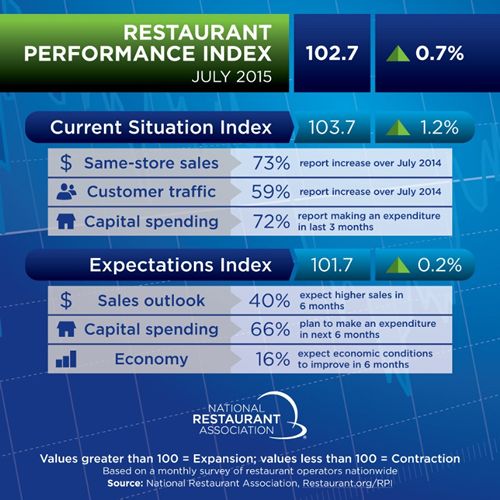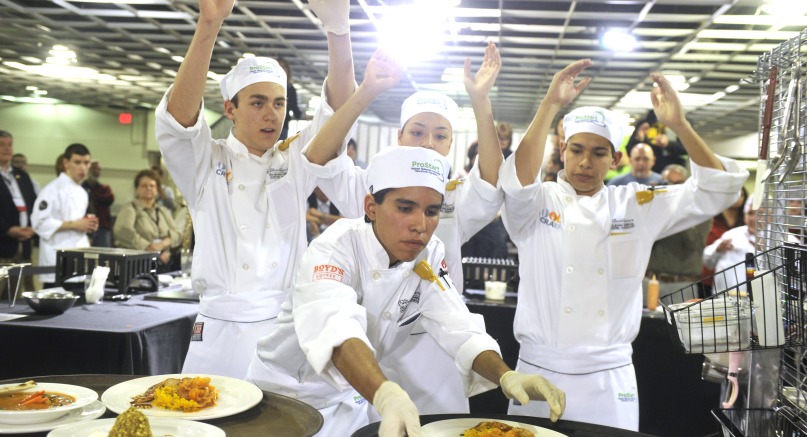Restaurant Performance Index Rose in July
/Driven by stronger same-store sales and customer traffic levels, the National Restaurant Association’s Restaurant Performance Index (RPI) posted a solid gain in July. The RPI – a monthly composite index that tracks the health of and outlook for the U.S. restaurant industry – stood at 102.7 in July, up 0.7 percent from June and the first gain in three months. In addition, July represented the 29th consecutive month in which the RPI stood above 100, which signifies expansion in the index of key industry indicators.
“July’s RPI gain was fueled primarily by an improvement in the current situation indicators,” said Hudson Riehle, Senior Vice President of the Research and Knowledge Group, National Restaurant Association. “Although a solid majority of operators reported higher same-store sales and customer traffic levels in July, their outlook for both sales growth and the economy is more cautious compared to recent months.”
The RPI is constructed so that the health of the restaurant industry is measured in relation to a steady-state level of 100. Index values above 100 indicate that key industry indicators are in a period of expansion, while index values below 100 represent a period of contraction for key industry indicators. The Index consists of two components – the Current Situation Index and the Expectations Index.

Current Situation Index
The Current Situation Index, which measures current trends in four industry indicators (same-store sales, traffic, labor and capital expenditures), stood at 103.7 in July – up 1.2 percent from June and the strongest increase since December 2014. In addition, the Current Situation Index stood above 100 for the 17th consecutive month, which signifies expansion in the current situation indicators.
- Same store sales: A majority of restaurant operators reported higher same-store sales for the 17th consecutive month, with July’s results representing the strongest performance since April. Seventy-three percent of restaurant operators reported a same-store sales gain between July 2014 and July 2015, up from 64 percent who reported higher sales in June. In comparison, 16 percent of operators reported a same-store sales decline in July, down from 20 percent in June.
- Customer Traffic: Restaurant operators also reported stronger customer traffic results in July. Fifty-nine percent of restaurant operators reported an increase in customer traffic between July 2014 and July 2015, up from 47 percent who reported higher traffic in June. Twenty-three percent of operators said their traffic declined in July, down from 28 percent in June.
- Capital spending: Along with positive same-store sales and customer traffic levels in recent months, restaurant operators continued to make capital expenditures. Seventy-two percent of operators said they made a capital expenditure for equipment, expansion or remodeling during the last three months, which marked the 10th consecutive month in which a majority of operators reported making an expenditure.
Expectations Index
The Expectations Index, which measures restaurant operators’ six-month outlook for four industry indicators (same-store sales, employees, capital expenditures and business conditions), stood at 101.7 in July – up slightly from a level of 101.5 in June. Overall, July represented the 33rd consecutive month in which the Expectations Index stood above 100, which indicates restaurant operators remain generally positive about business conditions in the months ahead.
- Sales outlook: Restaurant operators’ outlook for sales growth softened somewhat in recent months. Forty percent of restaurant operators expect to have higher sales in six months (compared to the same period in the previous year), which represented the fourth consecutive month of declining optimism. In comparison, 12 percent of restaurant operators expect their sales volume in six months to be lower than it was during the same period in the previous year, the highest level in 12 months.
- Overall economy: Similarly, restaurant operators are less bullish about the direction of the overall economy. Only 16 percent of restaurant operators said they expect economic conditions to improve in six months, while 21 percent expect conditions to worsen. This marked the second consecutive month with a net negative outlook, the first such occurrence in nearly three years.
- Capital expenditure planning: Despite the dampened outlook, a majority of restaurant operators said they are planning for capital expenditures in the months ahead. Sixty-six percent of restaurant operators plan to make a capital expenditure for equipment, expansion or remodeling in the next six months, up from 59 percent who reported similarly last month.

(via Restaurant News)












 What began almost three years ago with the labor protest movement in New York City has led to higher wages for workers across the whole country. On Wednesday, the movement came back full circle and now, people in NYC are getting the raise they have been protesting for.
What began almost three years ago with the labor protest movement in New York City has led to higher wages for workers across the whole country. On Wednesday, the movement came back full circle and now, people in NYC are getting the raise they have been protesting for.